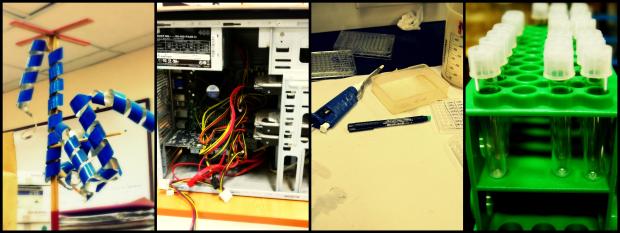
Photo: Siddharth Kankaria / Research Matters
A recent report by the World Health Organization estimates that about two million deaths occur every year due to tuberculosis (TB). An alarming dimension to this problem is the fact that some strains of Mycobacterium tuberculosis (Mtb), the causative agent of TB, have developed resistance to some antibiotics used to kill them, leading to the emergence of ‘drug resistant TB’ and causing a global threat. Drug resistance is a way by which bacteria respond to the drug stress they face. Due to improper and irregular use of antibiotics by patients, not all bacteria may be killed, leading to the emergence of drug resistant strains that survive even when further doses of the drug are administered. Now, a team of researchers at the Indian Institute of Science, Bangalore, led by Prof. Nagasuma Chandra and Prof. Amit Singh, have explored the mechanism behind the development of resistance to a front-line anti-tubercular drug called isoniazid, used widely in the clinic.
The researchers evolved a drug resistant strain of a model species in the laboratory and used a combined approach involving genomics, computational modeling, systems biology, genetic assays, and chemical and sensor based tools to study the mechanisms behind drug resistance. Based on the results, the researchers have, for the first time, reported a complete landscape of the genetic and phenotypic changes occurring in the model organism during the evolution of drug-resistance. They observed that, in addition to genetic changes, the bacteria acquired new characteristics in its transition from a ‘drug-sensitive’ strain to a ‘drug-resistant’ strain. Conventional antibiotics used to treat TB ultimately cause oxidative stress in Mtb, leading to its death. Their observations showed that the drug resistant strain developed an ability to respond to the oxidative stress by switching on its antioxidant machinery and thereby neutralizing the oxidative stress caused by the antibiotic. This was observed both in the model system and in the virulent strain of Mtb.
So how do we overcome the problem of drug resistance? The researchers have identified an Achilles’ heel in the drug-resistant strains - vulnerable spots that exist despite the overall fitness. They hypothesized that targeting the bacterial antioxidant mechanisms may kill the resistant bacilli and identified a new class of drugs including ebselen, vancomycin and phenylarsine oxide that inhibit the bacterial antioxidant responses. They found that when any of these drugs were used in combination with isoniazid, the drug to which the strain is resistant to, the efficacy of the drug in killing the resistant strains was much higher than when these drugs were used individually.
Further experiments confirmed that the combination of isoniazid with other antibiotics indeed reversed the resistance and rescued sensitivity of the strain to the initial drug. The researchers also observed that the combination increased the potency of isoniazid several fold in drug-sensitive and drug-resistant strains, implying that even when there is no drug resistance, the combination can lower the amount of isoniazid required, thus reducing the chances of side effects. Among the new drug combinations studied, ebselen and vancomycin, in combination with isoniazid, were found to be the most promising candidates for combating drug resistant TB.
The researchers believe that this study has opened new avenues of research on drug-resistant TB, which can further be exploited to make new strategies for targeting TB infections. “Our work has identified new compounds, which when combined with an existing anti-TB drug, can rescue drug sensitivity and enhance killing of the drug-resistant mycobacteria. Of these compounds, vancomycin, is already in use for treating other bacterial infections. Hence, we propose that this can be easily explored for the treatment of drug-resistant TB infection too. We are currently testing these combinations in animal models of TB infection”, say Profs. Chandra and Singh on their future plan.






